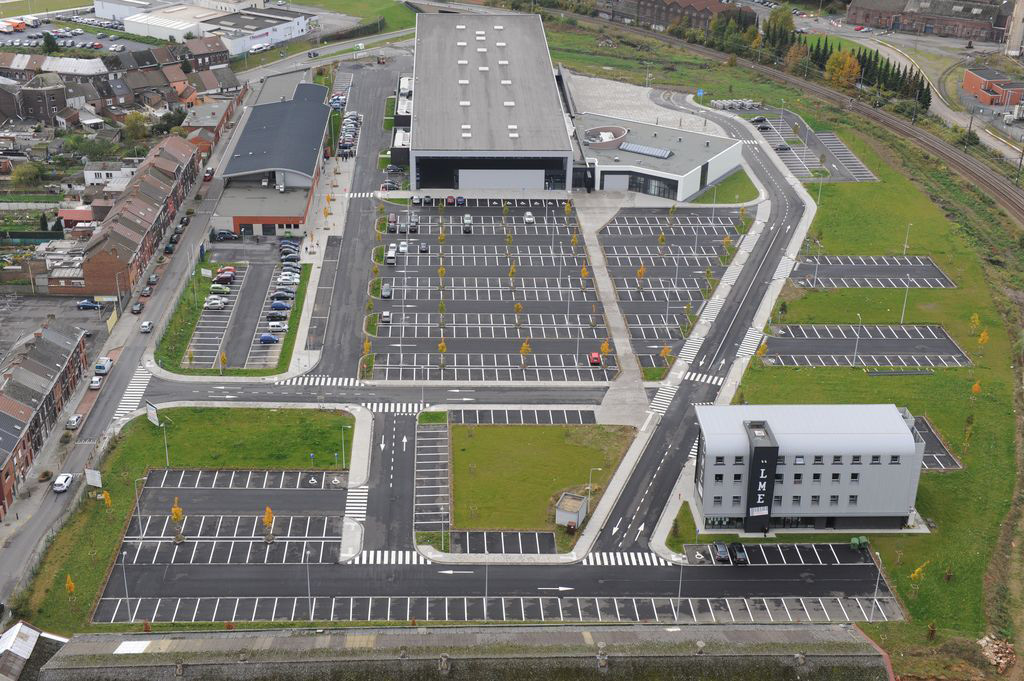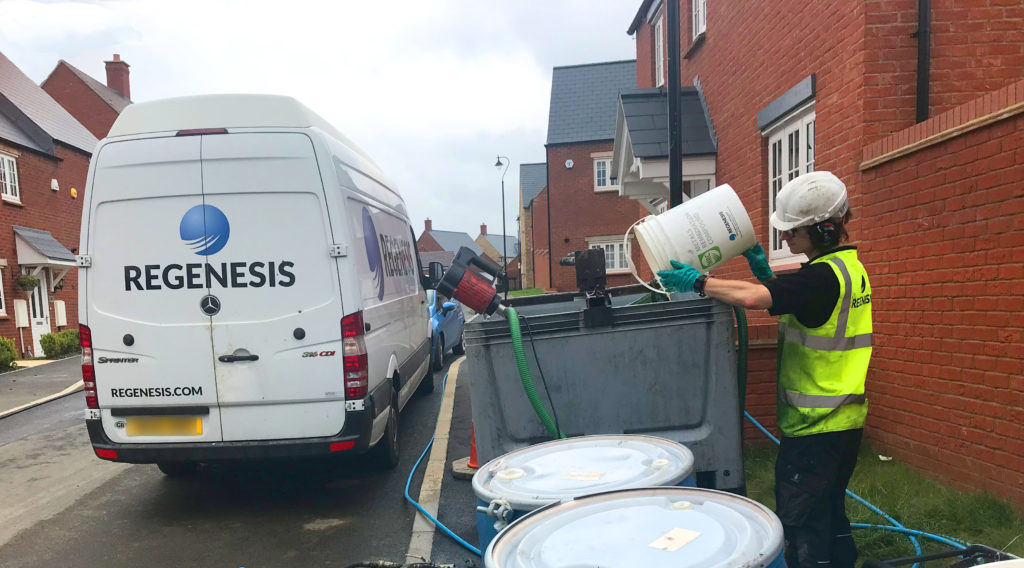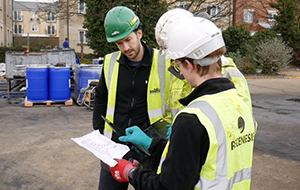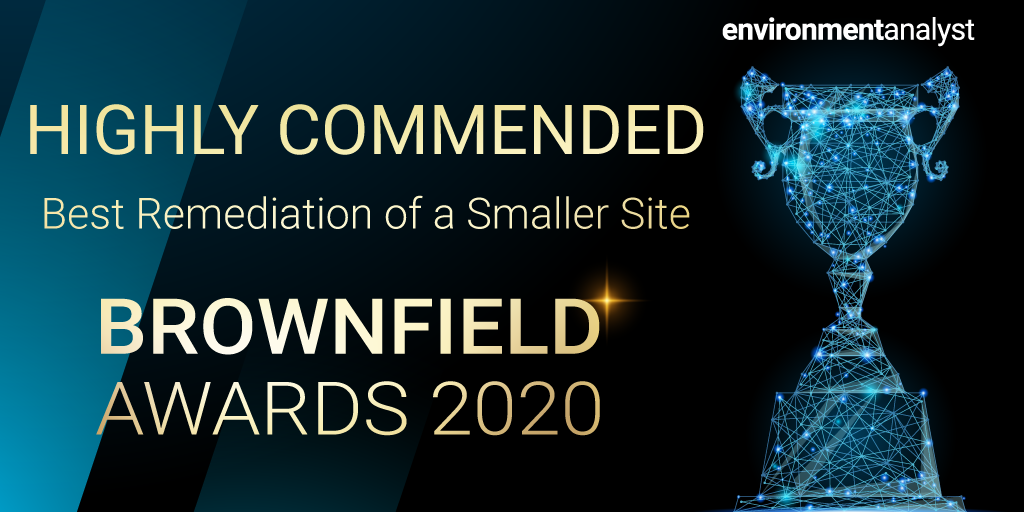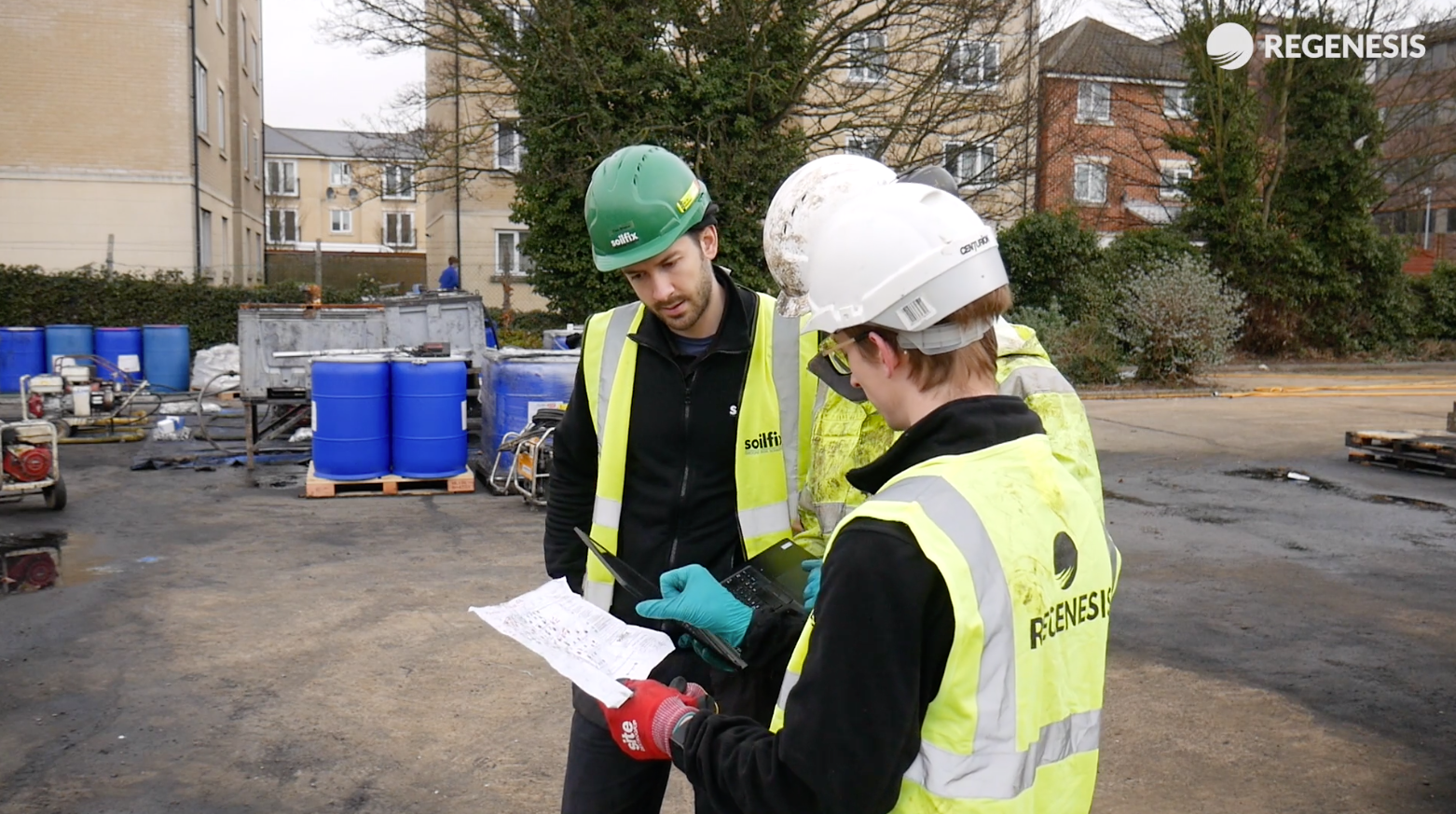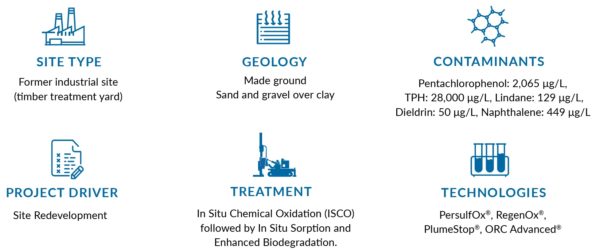Remediation of chlorinated solvents under a commercial development, Belgium
Summary:
In Belgium, the former Ubell metal-working factory, which had stood abandoned since the 1990’s, was chosen by Spaque to be redevelopment for commercial use. Significant amounts of chlorinated solvents had been observed in the groundwater, both widespread and with high concentrations in the source area. Reductive dechlorination was seen to be occurring naturally, but was stalling at cis-1,2 DCE due to a carbon-limited system. REGENESIS designed a remediation approach that would use a slow release electron donor to enhance and maintain full and effective reductive dechlorination (Enhanced Reductive Dechlorination (ERD)) of the target contamination.
Case study highlights:
- How a single application of 3DME resulted in the full reductive dechlorination of a large plume of chlorinated solvents
- How this simple and inexpensive treatment allowed the redevelopment of a highly impacted brownfield site, while allowing construction and economic use to go ahead unimpeded by the remediation occurred beneath the ground
4m 38s reading time
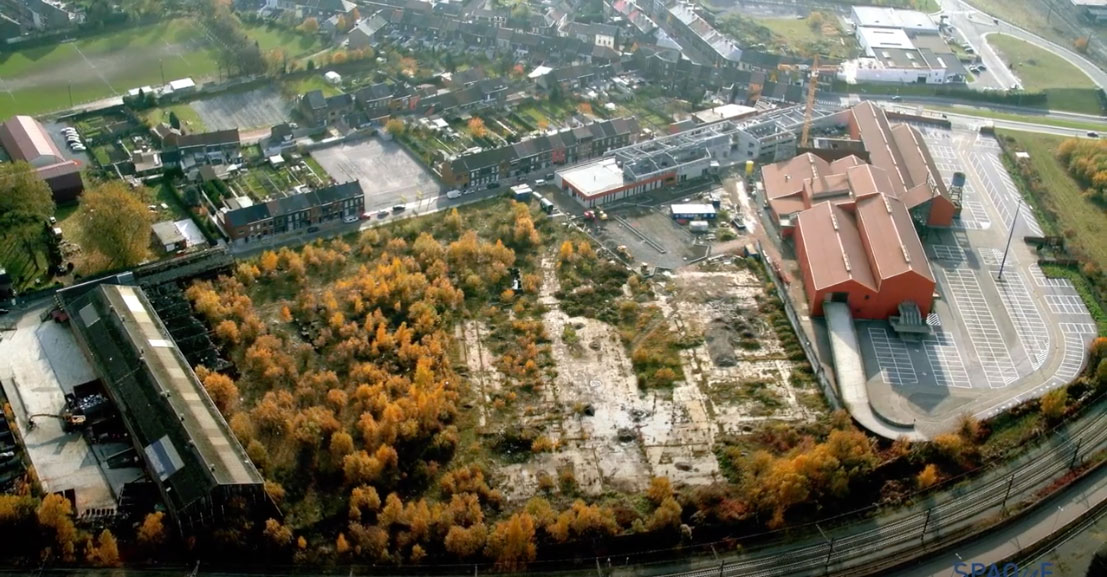
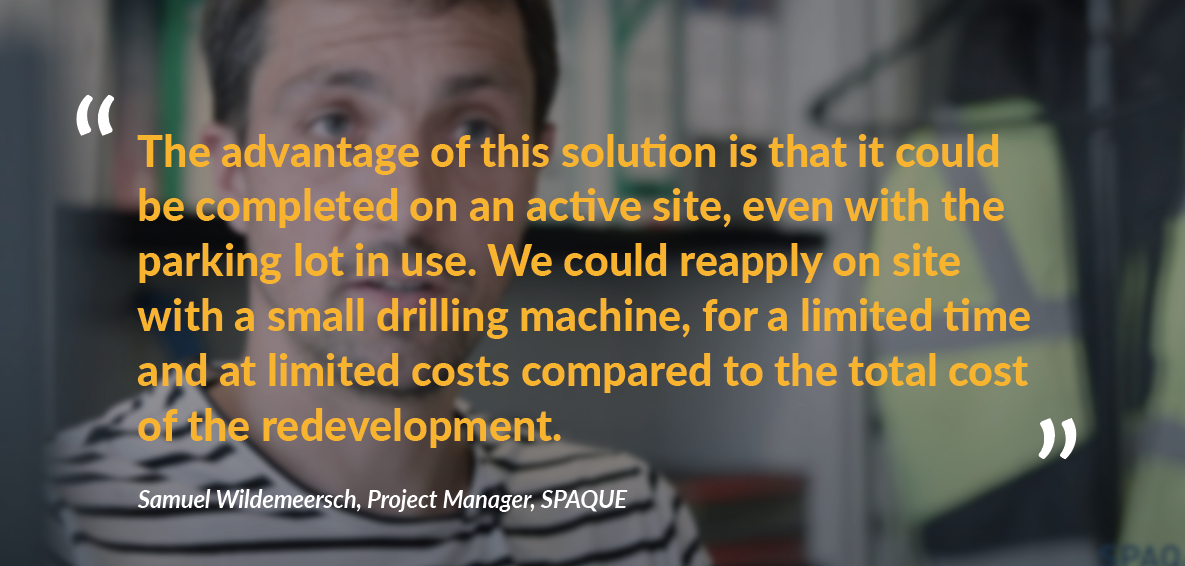
In Situ Remediation of CHCs within a Bedrock Aquifer, Germany
Case study: High concentrations of chlorinated hydrocarbons (CHCs) were observed in a sandstone bedrock underneath a school in Bavaria, southwest Germany. Environmental Consultant Wood worked with REGENESIS to develop an in-situ groundwater remediation solution for the site.Read More
PlumeStop Arrests PCE in Fast Moving Aquifer
This case study reviews a former dry-cleaning site in Martinsville, Indiana that had a perchloroethylene (PCE) release which contaminated the community’s groundwater with concentrations in excess of 370 parts per billion (ppb). The sand and gravel aquifer created a challenging problem due to the high flow regime, with a groundwater velocity of approximately 1,560 ft/year and oxygenated geochemistry which had limited natural attenuation. After a thorough evaluation of possible technologies, environmental consulting firm Wilcox Environmental Engineering determined that PlumeStop® Liquid Activated Carbon™ in combination with HRC® and BDI Plus® could prevent the plume from migrating and would work in the well-oxygenated, sand and gravel lithology.
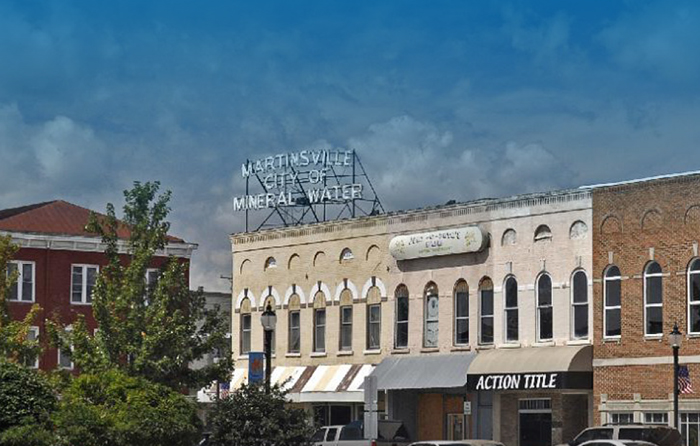
Case study highlights:
- PlumeStop effectively treated the plume in the well-oxygenated, sand and gravel lithology
- 99% reduction of PCE ~30 days after the application in key monitoring wells
- Demonstration of PRB leading to full-scale treatment in Spring 2020
6m 44s reading time
Treatment of Cr(VI) and CHC Groundwater Contamination under a Residential Development
In situ remediation of hexavalent chromium (VI) and chlorinated solvents using combined anaerobic biodegradation and immobilisation in Northampton, UK
Background
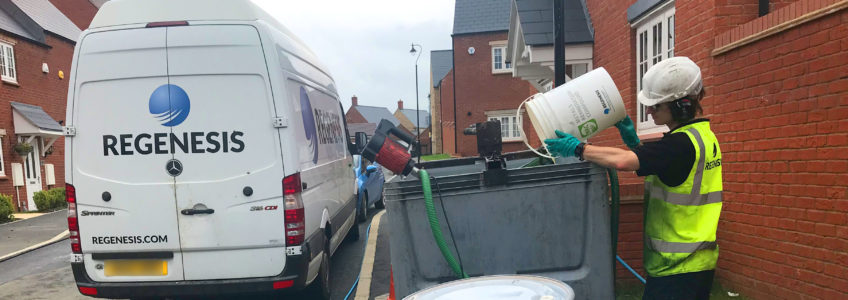
On the site of a former chrome plating works, construction and inhabitation had begun on a new residential development. Hexavalent chromium (Cr(VI)) and some chlorinated hydrocarbon compounds (CHCs) had been discovered in the groundwater beneath the development. It was determined by the environmental consultant that the Cr(VI) was driving a risk on the site. The housebuilder required rapid achievement of site targets in order to continue the development of the site.
Case Study Highlights
- REGENESIS provided an accurate and pragmatic design approach for the busy residential construction site
- Full-scale remediation was completed comprising a of a series of rows, totalling 78 injection points, to fit in between the residential properties and services
- A mixed plume of CHCs and Cr(VI) was treated concurrently using a combination of complementary substrates
- The works were completed rapidly with minimal disruption to the construction project and existing residents
- The use of barriers, targeting hotspots and pathways provided a cost-effective and efficient treatment of the plume
- Remediation Cost and Result Graph included
2m 40s reading time
Remediation Products Applied
A combination of ERD and in situ immobilisation using 3-D Microemulsion (3DME) and Metals Remediation Compound (MRC) has been used to primarily to treat the Cr(VI) contamination.
Pesticides, VOCs and petroleum hydrocarbons remediated with a suite of in situ technologies
Shallow aquifer treatment using RegenOx, PersulfOx, ORC Advanced and PlumeStop at a former industrial site, UK
This project was Highly Commended in the Brownfield Awards 2020 in the category of ‘Best Remediation of a Smaller Site’.
Located in East Anglia, this industrial site had been occupied by a timber yard, incinerator, fuel storage tanks and a saw mill. These were later demolished and the site-use changed to light commerical and a car park for a FTSE 100 Company. It was decided that the site should be prepared for redevelopment and a due diligence site investigation was carried out by Ramboll to support lease surrender.
It was discovered that in a corner of the site, the soils and groundwater were impacted with a wide range of contaminants including petroleum hydrocarbons, volatile organic compounds (VOC’s) including BTEX, trimethylbenzene, pentachlorophenol and a mix of pesticides, including organochlorine pesticides (Dieldrin) and gamma-HCH (Lindane). Soilfix worked closely with Ramboll and REGENESIS to deliver a tailored multi-phase remediation solution for the site, including in situ remediation using a suite of REGENESIS’ remediation technologies.
REGENESIS services team carried out the groundwater remediation works on-site which included a combination of in situ chemical oxidation, sorption and enhanced biological degradation. Click the case study link to find out more, or watch the project video.
7m 3s reading time
“The project was a great success. Not only did we meet the betterment-based objectives that we agreed with the Client’s consultant Ramboll; for many of the contaminants we ended up meeting the stringent criteria that were originally derived by the risk assessment. This enabled the Client to surrender their lease on their programme. We felt this was largely down to the project team approach that we took with REGENESIS, from conception through to validation and completion of the project.”
Steve Jackson, Director, Soilfix
Case study highlights:
- Soilfix, Ramboll and REGENESIS worked together to develop a tailored multi-phase remediation solution.
- Integrated application of remediation products: RegenOx, PersulfOx, PlumeStop and ORC Advanced.
- Validation results show a rapid and sustained reduction in the concentration of all contaminants of concern (COCs).
- Remedial targets were achieved in time for lease surrender, with all stakeholders satisfied with the works completed.
Global Retailer Enters Into Elective Site Cleanup Agreement and Achieves NFA
This case study reviews the site of a global retailer based in Arkansas, where historic offsite dry cleaning operations caused tetrachloroethylene (PCE) contamination in the groundwater. A previous bioremediation attempt successfully remediated a majority of the site but one persistent well remained. After time passed with little change to the B-45 well, ESGI sought out a bioremediation strategy that would work quickly with long term success. ESGI partnered with REGENESIS to design a bioremediation plan that would apply PlumeStop®, Liquid activated Carbon, Hyrdogren Release Compound® (HRC) and Bio-Dechlor Inoculum® (BDI Plus) to eliminate the remaining contaminants of concern (COCs). After the applications of PlumeStop, HRC, and BDI Plus, all COCs were below the acceptable threshold levels, and as a result the site achieved No Further Action (NFA) in January of 2020.

Case study highlights:
- PlumeStop, HRC, and BDI Plus successfully remediated persistent PCE, VC, and Cis-1,2-DCE contamination.
- Environmental services firm ESGI and REGENESIS adapted the injection design according to the difficult site geology and weather conditions.
- After one round of injections, successful results led to the site achieving NFA.
6m 3s reading time
Cost-Effective Treatment To Address PCE At Former Dry Cleaning Site
This case study reviews a former dry cleaning site in an upscale Chicago suburb was contaminated with chlorinated solvents, specifically perchloroethylene. The former dry cleaner location is in a busy commercial area on a major thoroughfare and adjacent to upscale residential townhomes. Various treatments including soil excavation and removal and thermal desorption were considered, but were not feasible because they were too costly and disruptive to businesses and residents.

Case study highlights:
- Soil mixing with PersulfOx cost less than half of the thermal desorption treatment.
- Very aggressive remediation goals were met on a quick timeline.
- One application of PersulfOx was powerful enough to reduce contaminant levels from 18,000 ppm to 150 ppm.
Combined Amendment Approach Treats Chlorinated Solvents
This case study reviews a formerly undeveloped site in downtown Jacksonville that was impacted with chlorinated solvents in the groundwater and metal-impacted soils. To treat the chlorinated solvent groundwater plume, Terracon selected multiple technologies from REGENESIS, including PlumeStop, zero-valent iron (ZVI), Bio-Dechlor Inoculum Plus (BDI Plus), and Hydrogen Release Compound (HRC). The site required remediation prior to moving forward with development. Ryan Companies US, Inc. (Ryan) was under contract to purchase the property from the site owner and was seeking an expedited closure of the site prior to completion of construction. Ryan plans to develop the site with a nine-story office building and an associated nine-level parking deck. Site rehabilitation through remediation and regulatory closure is being sought through Florida Department of Environmental Protection (FDEP) voluntary cleanup. Environmental engineering and consulting firm Terracon evaluated a variety of remedial technologies as well as existing site conditions to determine the most appropriate application for the site.

Case study highlights:
- Combined remedy approach ensured effective remediation.
- FDEP Voluntary Cleanup program provided tax credits making the remediation and redevelopment possible.
- Remediation allowed the undeveloped block to be developed into a nine-story office building in a growing area of downtown Jacksonville.
6m 39s reading time
Real Estate Transaction Requires Fast-Acting Treatment of PCE Contamination
 This case study reviews a multi-tenant commercial plaza in the greater Boston area that required remediation of tetrachloroethylene (PCE) contamination in groundwater where a combined remedy approach used at delivered accelerated results using PlumeStop®, BDI Plus® and HRC®.
This case study reviews a multi-tenant commercial plaza in the greater Boston area that required remediation of tetrachloroethylene (PCE) contamination in groundwater where a combined remedy approach used at delivered accelerated results using PlumeStop®, BDI Plus® and HRC®.
Due to the owner’s objective to sell their property, a multi-tenant commercial plaza in the greater Boston area required remediation of tetrachloroethylene (PCE) contamination in groundwater associated with historical operations. Because contamination had been identified during due diligence, it was very important to implement a time-effective remediation strategy with minimal disruption to the various operating businesses. Wilcox & Barton, Inc. chose a combined remedial approach to treat the PCE contamination. This included liquid activated carbon (PlumeStop), an enriched, microbial consortium (BDI Plus), and an engineered, hydrogen release compound (HRC).
This case study highlights:
- Due to the high-traffic and operational hours at this site, injections were performed from 10pm-7am in January.
- The speed in which Wilcox & Barton, Inc. addressed the contaminants was crucial for the site owners to achieve their goal of marketing the property for sale.
- Site engineers innovatively included heating systems, additional lighting, and warming facilities to ensure that the remedial agents stayed in their liquid form and to provide necessary amenities to the injection specialists.
- The combined remedy approach of PlumeStop, BDI Plus, and HRC was selected amongst other remediation strategies for its fast-acting capabilities and its effectiveness in completely dechlorinating contaminants.
6m 33s reading time
ZVI Applied To Remediate DoD Superfund Site
Combined Remedy Effectively Treats 1,2-DCA and TCE at Tinker Air Force Base
This case study reviews the remediation of dichloroethane (1,2-DCA) and Trichloroethylene (TCE) using colloidal zero valent iron (ZVI) at Tinker Air Force Base, a major United States Air Force base located in Oklahoma City, Oklahoma. The remediation included an application of emulsified vegetable oil (EVO), an aqueous suspension of colloidal zero valent iron (MicroZVI Precursor), with small amounts of fertilizer and B12. Typically, zero valent iron cannot be applied through well systems. However, due to the small particle size of the zero valent iron, this application was successfully applied through the existing wells. At 3 years post-injection, the contaminant levels remain near zero with the presence of ethene indicating continuous biodegradation.
This case study features the following:
- Successful application of colloidal zero valent iron through well system
- At 3 years post-injection, the presence of ethene signals active biodegradation
- Aqueous suspension of colloidal zero valent iron effectively reduced contaminant levels

 Americas
Americas Europe
Europe Français
Français Deutsch
Deutsch Italiano
Italiano Español
Español